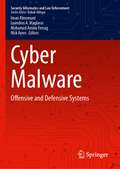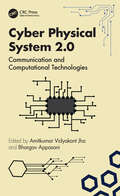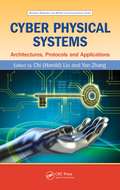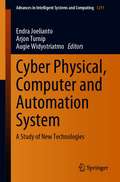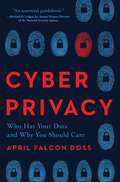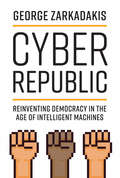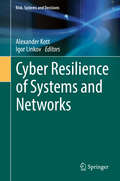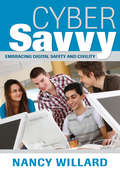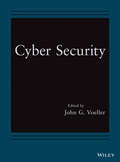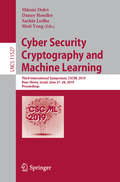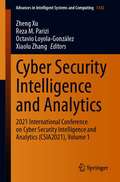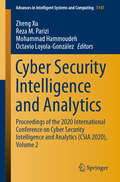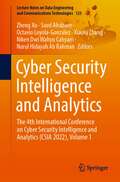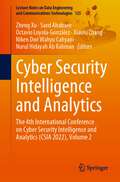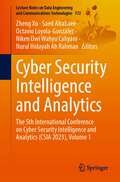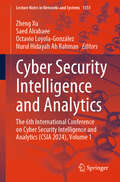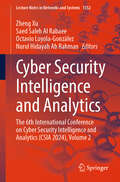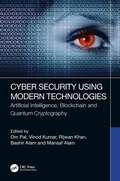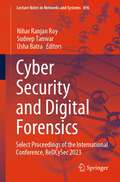- Table View
- List View
Cyber Malware: Offensive and Defensive Systems (Security Informatics and Law Enforcement)
by Leandros A. Maglaras Iman Almomani Mohamed Amine Ferrag Nick AyresThis book provides the foundational aspects of malware attack vectors and appropriate defense mechanisms against malware. The book equips readers with the necessary knowledge and techniques to successfully lower the risk against emergent malware attacks. Topics cover protections against malware using machine learning algorithms, Blockchain and AI technologies, smart AI-based applications, automated detection-based AI tools, forensics tools, and much more. The authors discuss theoretical, technical, and practical issues related to cyber malware attacks and defense, making it ideal reading material for students, researchers, and developers.
Cyber Physical System 2.0: Communication and Computational Technologies
by Bhargav Appasani Amitkumar Vidyakant JhaThe book covers the emerging communication and computational technologies for future cyber-physical systems and discusses the security of in-vehicle communication protocols using automotive embedded systems, presenting an in-depth analysis across various domains, such as manufacturing, transportation, health-care, and smart cities.This book: Discusses how communication and computing co-design provides dynamic adaptability and centralized control. Presents the convergence of physical and digital realities within the metaverse and multiverse, setting the stage for the future of cyber-physical-social systems (CPSS). Presents emerging communication and computational technologies, such as 6G, software-defined networking, cloud computing, blockchain, artificial intelligence, machine learning, virtual reality, and blockchain, for the design and implementation of cyber-physical systems. Explores advanced topics such as security and privacy in industrial CPS, strategies for protecting serial industrial networks, and enhancing firmware update security in automotive systems. It is primarily written for senior undergraduates, graduate students, and academic researchers in the fields of electrical engineering, electronics and communication engineering, computer science and engineering, and information technology.
Cyber Physical Systems: Architectures, Protocols and Applications
by Yan Zhang Chi Harold LiuCyber Physical Systems: Architectures, Protocols and Applications helps you understand the basic principles and key supporting standards of CPS. It analyzes different CPS applications from the bottom up, extracting the common characters that form a vertical structure. It presents mobile sensing platforms and their applications toward interrelated p
Cyber Physical, Computer and Automation System: A Study of New Technologies (Advances in Intelligent Systems and Computing #1291)
by Endra Joelianto Arjon Turnip Augie WidyotriatmoThis book is a collection of extended papers presented at the Cyber Physical, Computer and Automation System (CPCAS 2019), Bali – Indonesia, 13–15 November 2019. The book includes chapters in three prime areas: (1) autonomous systems and controls; (2) human–machine interaction and human-related engineering; and (3) interconnected things. Autonomous systems and controls are systems of engineering that work with or without human intervention. Human–machine interaction involves sensor and actuator technology to detect human behavior, intentions, and decisions and also to provide the ability of a machine to interact with humans to achieve the expected performance. Interconnected things consist of a network of computer-controlled physical mechanisms communicating with each other for efficient operation and improving system capabilities.
Cyber Privacy: Who Has Your Data and Why You Should Care
by April Falcon Doss"Chilling, eye-opening, and timely, Cyber Privacy makes a strong case for the urgent need to reform the laws and policies that protect our personal data. If your reaction to that statement is to shrug your shoulders, think again. As April Falcon Doss expertly explains, data tracking is a real problem that affects every single one of us on a daily basis." —General Michael V. Hayden, USAF, Ret., former Director of CIA and NSA and former Principal Deputy Director of National Intelligence You're being tracked. Amazon, Google, Facebook, governments. No matter who we are or where we go, someone is collecting our data: to profile us, target us, assess us; to predict our behavior and analyze our attitudes; to influence the things we do and buy—even to impact our vote. If this makes you uneasy, it should. We live in an era of unprecedented data aggregation, and it's never been more difficult to navigate the trade-offs between individual privacy, personal convenience, national security, and corporate profits. Technology is evolving quickly, while laws and policies are changing slowly. You shouldn't have to be a privacy expert to understand what happens to your data. April Falcon Doss, a privacy expert and former NSA and Senate lawyer, has seen this imbalance in action. She wants to empower individuals and see policy catch up. In Cyber Privacy, Doss demystifies the digital footprints we leave in our daily lives and reveals how our data is being used—sometimes against us—by the private sector, the government, and even our employers and schools. She explains the trends in data science, technology, and the law that impact our everyday privacy. She tackles big questions: how data aggregation undermines personal autonomy, how to measure what privacy is worth, and how society can benefit from big data while managing its risks and being clear-eyed about its cost. It's high time to rethink notions of privacy and what, if anything, limits the power of those who are constantly watching, listening, and learning about us. This book is for readers who want answers to three questions: Who has your data? Why should you care? And most important, what can you do about it?
Cyber Racism and Community Resilience: Strategies for Combating Online Race Hate (Palgrave Hate Studies)
by Karen Connelly Andrew Jakubowicz Kevin Dunn Gail Mason Yin Paradies Ana-Maria Bliuc Nasya Bahfen Andre Oboler Rosalie AtieThis book highlights cyber racism as an ever growing contemporary phenomenon. Its scope and impact reveals how the internet has escaped national governments, while its expansion is fuelling the spread of non-state actors. In response, the authors address the central question of this topic: What is to be done? Cyber Racism and Community Resilience demonstrates how the social sciences can be marshalled to delineate, comprehend and address the issues raised by a global epidemic of hateful acts against race. Authored by an inter-disciplinary team of researchers based in Australia, this book presents original data that reflects upon the lived, complex and often painful reality of race relations on the internet. It engages with the various ways, from the regulatory to the role of social activist, which can be deployed to minimise the harm often felt. This book will be of particular interest to students and academics in the fields of cybercrime, media sociology and cyber racism.
Cyber Republic: Reinventing Democracy in the Age of Intelligent Machines
by George ZarkadakisScience and tech expert George Zarkadakis presents an indispensable guide to making liberal democracies more inclusive, and the digital economy more equitable in the coming Fourth Industrial Revolution.Around the world, liberal democracies are in crisis. Citizens have lost faith in their government; right-wing nationalist movements frame the political debate. At the same time, economic inequality is increasing dramatically; digital technologies have created a new class of super-rich entrepreneurs. Automation threatens to transform the free economy into a zero-sum game in which capital wins and labor loses. But is this digital dystopia inevitable? In Cyber Republic, George Zarkadakis presents an alternative, outlining a plan for using technology to make liberal democracies more inclusive and the digital economy more equitable. Cyber Republic is no less than a guide for the coming Fourth Industrial Revolution.
Cyber Resilience of Systems and Networks (Risk, Systems and Decisions)
by Alexander Kott Igor LinkovThis book introduces fundamental concepts of cyber resilience, drawing expertise from academia, industry, and government. Resilience is defined as the ability to recover from or easily adjust to shocks and stresses. Unlike the concept of security - which is often and incorrectly conflated with resilience -- resilience refers to the system's ability to recover or regenerate its performance after an unexpected impact produces a degradation in its performance. A clear understanding of distinction between security, risk and resilience is important for developing appropriate management of cyber threats. The book presents insightful discussion of the most current technical issues in cyber resilience, along with relevant methods and procedures. Practical aspects of current cyber resilience practices and techniques are described as they are now, and as they are likely to remain in the near term.The bulk of the material is presented in the book in a way that is easily accessible to non-specialists. Logical, consistent, and continuous discourse covering all key topics relevant to the field will be of use as teaching material as well as source of emerging scholarship in the field. A typical chapter provides introductory, tutorial-like material, detailed examples, in-depth elaboration of a selected technical approach, and a concise summary of key ideas.
Cyber Savvy: Embracing Digital Safety and Civility
by Dr Nancy E. WillardHow to teach students online safety and citizenship Nancy Willard integrates her expertise in risk prevention, law, and education to provide a collaborative and positive process for teaching secondary students positive social norms, safety, and “netiquette.” She lays out the steps for school staff and students to work as a team in building an effective program that will teach young people how to: Keep themselves safe Disclose and consume information wisely Respect the rights, privacy, and property of others Take responsibility for others’ well-being when needed Respond to inappropriate or dangerous situations
Cyber Security
by John G. VoellerCyber Security features articles from the Wiley Handbook of Science and Technology for Homeland Security covering topics related to cyber security metrics and measure and related technologies that meet security needs. Specific applications to web services, the banking and the finance sector, and industrial process control systems are discussed.
Cyber Security Cryptography and Machine Learning: Third International Symposium, CSCML 2019, Beer-Sheva, Israel, June 27–28, 2019, Proceedings (Lecture Notes in Computer Science #11527)
by Moti Yung Shlomi Dolev Sachin Lodha Danny HendlerThis book constitutes the refereed proceedings of the Third International Symposium on Cyber Security Cryptography and Machine Learning, CSCML 2019, held in Beer-Sheva, Israel, in June 2019.The 18 full and 10 short papers presented in this volume were carefully reviewed and selected from 36 submissions. They deal with the theory, design, analysis, implementation, or application of cyber security, cryptography and machine learning systems and networks, and conceptually innovative topics in these research areas.
Cyber Security Impact on Digitalization and Business Intelligence: Big Cyber Security for Information Management: Opportunities and Challenges (Studies in Big Data #117)
by Muhammad Turki Alshurideh Haitham M. Alzoubi Taher M. GhazalThis book takes a unique approach by exploring the connection between cybersecurity, digitalization, and business intelligence. In today's digital landscape, cybersecurity is a crucial aspect of business operations. Meanwhile, organizations continue to leverage digital technologies for their day-to-day operations. They must be aware of the risks associated with cyber-attacks and implement robust cybersecurity measures to protect their assets. It provides practical insights and solutions to help businesses better understand the impact of cybersecurity on their digitalization and business intelligence strategies. It provides practical insights and solutions for implementing cybersecurity measures in organizations and covers a wide range of topics, including threat intelligence, risk management, compliance, cloud security, and IoT security. The book takes a holistic approach and explores the intersection of cybersecurity, digitalization, and business intelligence and examines the possible challenges and opportunities.
Cyber Security Intelligence and Analytics: 2021 International Conference on Cyber Security Intelligence and Analytics (CSIA2021), Volume 1 (Advances in Intelligent Systems and Computing #1342)
by Xiaolu Zhang Zheng Xu Reza M. Parizi Octavio Loyola-GonzálezThis book presents the outcomes of the 2021 International Conference on Cyber Security Intelligence and Analytics (CSIA 2021), an international conference dedicated to promoting novel theoretical and applied research advances in the interdisciplinary field of cyber security, particularly focusing on threat intelligence, analytics, and countering cybercrime. The conference provides a forum for presenting and discussing innovative ideas, cutting-edge research findings and novel techniques, methods and applications on all aspects of cyber security intelligence and analytics. Due to COVID-19, Authors, Keynote Speakers and PC committees will attend the conference online.
Cyber Security Intelligence and Analytics: 2021 International Conference on Cyber Security Intelligence and Analytics (CSIA2021), Volume 2 (Advances in Intelligent Systems and Computing #1343)
by Xiaolu Zhang Zheng Xu Reza M. Parizi Octavio Loyola-GonzálezThis book presents the outcomes of the 2021 International Conference on Cyber Security Intelligence and Analytics (CSIA 2021), an international conference dedicated to promoting novel theoretical and applied research advances in the interdisciplinary field of cyber security, particularly focusing on threat intelligence, analytics, and countering cybercrime. The conference provides a forum for presenting and discussing innovative ideas, cutting-edge research findings and novel techniques, methods and applications on all aspects of cyber security intelligence and analytics. Due to COVID-19, Authors, Keynote Speakers and PC committees will attend the conference online.
Cyber Security Intelligence and Analytics: Proceedings of the 2020 International Conference on Cyber Security Intelligence and Analytics (CSIA 2020), Volume 1 (Advances in Intelligent Systems and Computing #1146)
by Zheng Xu Mohammad Hammoudeh Reza M. Parizi Octavio Loyola-GonzálezThis book presents the outcomes of the 2020 International Conference on Cyber Security Intelligence and Analytics (CSIA 2020), which was dedicated to promoting novel theoretical and applied research advances in the interdisciplinary field of cyber security, particularly those focusing on threat intelligence, analytics, and preventing cyber crime. The conference provides a forum for presenting and discussing innovative ideas, cutting-edge research findings, and novel techniques, methods, and applications concerning all aspects of cyber security intelligence and analytics. CSIA 2020, which was held in Haikou, China on February 28–29, 2020, built on the previous conference in Wuhu, China (2019), and marks the series’ second successful installment.
Cyber Security Intelligence and Analytics: Proceedings of the 2020 International Conference on Cyber Security Intelligence and Analytics (CSIA 2020), Volume 2 (Advances in Intelligent Systems and Computing #1147)
by Zheng Xu Mohammad Hammoudeh Reza M. Parizi Octavio Loyola-GonzálezThis book presents the outcomes of the 2020 International Conference on Cyber Security Intelligence and Analytics (CSIA 2020), an international conference dedicated to promoting novel theoretical and applied research advances in the interdisciplinary field of cyber security, particularly focusing on threat intelligence, analytics, and countering cyber crime. The conference provides a forum for presenting and discussing innovative ideas, cutting-edge research findings, and novel techniques, methods and applications on all aspects of Cyber Security Intelligence and Analytics. The 2020 International Conference on Cyber Security Intelligence and Analytics (CSIA 2020) is held at Feb. 28-29, 2020, in Haikou, China, building on the previous successes in Wuhu, China (2019) is proud to be in the 2nd consecutive conference year.
Cyber Security Intelligence and Analytics: The 4th International Conference on Cyber Security Intelligence and Analytics (CSIA 2022), Volume 1 (Lecture Notes on Data Engineering and Communications Technologies #123)
by Xiaolu Zhang Zheng Xu Saed Alrabaee Octavio Loyola-González Niken Dwi Wahyu Cahyani Nurul Hidayah Ab RahmanThis book presents the outcomes of the 2022 4th International Conference on Cyber Security Intelligence and Analytics (CSIA 2022), an international conference dedicated to promoting novel theoretical and applied research advances in the interdisciplinary field of cyber-security, particularly focusing on threat intelligence, analytics, and countering cyber-crime. The conference provides a forum for presenting and discussing innovative ideas, cutting-edge research findings and novel techniques, methods and applications on all aspects of cyber-security intelligence and analytics. Due to COVID-19, authors, keynote speakers and PC committees will attend the conference online.
Cyber Security Intelligence and Analytics: The 4th International Conference on Cyber Security Intelligence and Analytics (CSIA 2022), Volume 2 (Lecture Notes on Data Engineering and Communications Technologies #125)
by Xiaolu Zhang Zheng Xu Saed Alrabaee Octavio Loyola-González Niken Dwi Wahyu Cahyani Nurul Hidayah Ab RahmanThis book presents the outcomes of the 2022 4th International Conference on Cyber Security Intelligence and Analytics (CSIA 2022), an international conference dedicated to promoting novel theoretical and applied research advances in the interdisciplinary field of cyber-security, particularly focusing on threat intelligence, analytics, and countering cyber-crime. The conference provides a forum for presenting and discussing innovative ideas, cutting-edge research findings and novel techniques, methods and applications on all aspects of cyber-security intelligence and analytics. Due to COVID-19, authors, keynote speakers and PC committees will attend the conference online.
Cyber Security Intelligence and Analytics: The 5th International Conference on Cyber Security Intelligence and Analytics (CSIA 2023), Volume 1 (Lecture Notes on Data Engineering and Communications Technologies #172)
by Zheng Xu Saed Alrabaee Octavio Loyola-González Niken Dwi Wahyu Cahyani Nurul Hidayah Ab RahmanThis book provides the proceedings of the 5th International Conference on Cyber Security Intelligence and Analytics. The 5th International Conference on Cyber Security Intelligence and Analytics (CSIA 2023) is an international conference dedicated to promoting novel theoretical and applied research advances in the interdisciplinary agenda of cyber security, particularly focusing on threat intelligence and analytics and countering cybercrime. Cyber security experts, including those in data analytics, incident response and digital forensics, need to be able to rapidly detect, analyze and defend against a diverse range of cyber threats in near real-time conditions. We are organizing the CSIA 2023 at Radisson Blu Shanghai Pudong Jinqiao Hotel. It will feature a technical program of refereed papers selected by the international program committee, keynote address.
Cyber Security Intelligence and Analytics: The 5th International Conference on Cyber Security Intelligence and Analytics (CSIA 2023), Volume 2 (Lecture Notes on Data Engineering and Communications Technologies #173)
by Zheng Xu Saed Alrabaee Octavio Loyola-González Niken Dwi Wahyu Cahyani Nurul Hidayah Ab RahmanThis book provides the proceedings of the 5th International Conference on Cyber Security Intelligence and Analytics. The 5th International Conference on Cyber Security Intelligence and Analytics (CSIA 2023) is an international conference dedicated to promoting novel theoretical and applied research advances in the interdisciplinary agenda of cyber security, particularly focusing on threat intelligence and analytics and countering cybercrime. Cyber security experts, including those in data analytics, incident response and digital forensics, need to be able to rapidly detect, analyze and defend against a diverse range of cyber threats in near real-time conditions. We are organizing the CSIA 2023 at Radisson Blu Shanghai Pudong Jinqiao Hotel. It will feature a technical program of refereed papers selected by the international program committee, keynote address.
Cyber Security Intelligence and Analytics: The 6th International Conference on Cyber Security Intelligence and Analytics (CSIA 2024), Volume 1 (Lecture Notes in Networks and Systems #1351)
by Zheng Xu Saed Alrabaee Octavio Loyola-González Nurul Hidayah Ab RahmanThis book delves into the latest advancements and innovations in big data analytics as applied to cyber-physical systems within smart city frameworks. Key themes include the integration of IoT, AI, and machine learning for enhanced urban management, sustainable development, and improved quality of life. The book showcases cutting-edge research, practical case studies, and expert insights, making it an invaluable resource for understanding the transformative potential of big data in creating smarter, more connected cities. Don't miss out on this authoritative guide to the future of smart city analytics
Cyber Security Intelligence and Analytics: The 6th International Conference on Cyber Security Intelligence and Analytics (CSIA 2024), Volume 2 (Lecture Notes in Networks and Systems #1352)
by Zheng Xu Octavio Loyola-González Nurul Hidayah Ab Rahman Saed Saleh Al RabaeeThis book delves into the latest advancements and innovations in big data analytics as applied to cyber-physical systems within smart city frameworks. Key themes include the integration of IoT, AI, and machine learning for enhanced urban management, sustainable development, and improved quality of life. The book showcases cutting-edge research, practical case studies, and expert insights, making it an invaluable resource for understanding the transformative potential of big data in creating smarter, more connected cities. Don't miss out on this authoritative guide to the future of smart city analytics
Cyber Security Using Modern Technologies: Artificial Intelligence, Blockchain and Quantum Cryptography
by Vinod Kumar Mansaf Alam Om Pal Rijwan Khan Bashir AlamThe main objective of this book is to introduce cyber security using modern technologies such as Artificial Intelligence, Quantum Cryptography, and Blockchain. This book provides in-depth coverage of important concepts related to cyber security. Beginning with an introduction to Quantum Computing, Post-Quantum Digital Signatures, and Artificial Intelligence for cyber security of modern networks and covering various cyber-attacks and the defense measures, strategies, and techniques that need to be followed to combat them, this book goes on to explore several crucial topics, such as security of advanced metering infrastructure in smart grids, key management protocols, network forensics, intrusion detection using machine learning, cloud computing security risk assessment models and frameworks, cyber-physical energy systems security, a biometric random key generator using deep neural network and encrypted network traffic classification. In addition, this book provides new techniques to handle modern threats with more intelligence. It also includes some modern techniques for cyber security, such as blockchain for modern security, quantum cryptography, and forensic tools. Also, it provides a comprehensive survey of cutting-edge research on the cyber security of modern networks, giving the reader a general overview of the field. It also provides interdisciplinary solutions to protect modern networks from any type of attack or manipulation. The new protocols discussed in this book thoroughly examine the constraints of networks, including computation, communication, and storage cost constraints, and verifies the protocols both theoretically and experimentally. Written in a clear and comprehensive manner, this book would prove extremely helpful to readers. This unique and comprehensive solution for the cyber security of modern networks will greatly benefit researchers, graduate students, and engineers in the fields of cryptography and network security.
Cyber Security and Digital Forensics: Proceedings of ICCSDF 2021 (Lecture Notes on Data Engineering and Communications Technologies #73)
by Vania Vieira Estrela Kavita Khanna Joel José Puga Coelho RodriguesThis book features high-quality research papers presented at the International Conference on Applications and Techniques in Cyber Security and Digital Forensics (ICCSDF 2021), held at The NorthCap University, Gurugram, Haryana, India, during April 3–4, 2021. This book discusses the topics ranging from information security to cryptography, mobile application attacks to digital forensics, and from cyber security to blockchain. The goal of the book is to provide 360-degree view of cybersecurity to the readers which include cyber security issues, threats, vulnerabilities, novel idea, latest technique and technology, and mitigation of threats and attacks along with demonstration of practical applications. This book also highlights the latest development, challenges, methodologies as well as other emerging areas in this field. It brings current understanding of common Web vulnerabilities while maintaining awareness and knowledge of contemporary standards, practices, procedures, and methods of Open Web Application Security Project. It also expounds how to recover information after a cybercrime.
Cyber Security and Digital Forensics: Select Proceedings of the International Conference, ReDCySec 2023 (Lecture Notes in Networks and Systems #896)
by Usha Batra Nihar Ranjan Roy Sudeep TanwarThe book contains peer-reviewed papers from the International Conference on Recent Developments in Cyber Security organized by the Center for Cyber Security and Cryptology at Sharda University in June 2023. This volume focuses on privacy and secrecy of information, cryptography, applications and analysis, cyber threat intelligence and mitigation, cyber-physical systems, cyber threat intelligence, quantum cryptography and blockchain technologies and their application, etc. This book is a unique collection of chapters from different areas with a common theme and will be immensely useful to academic researchers and practitioners in the industry.
